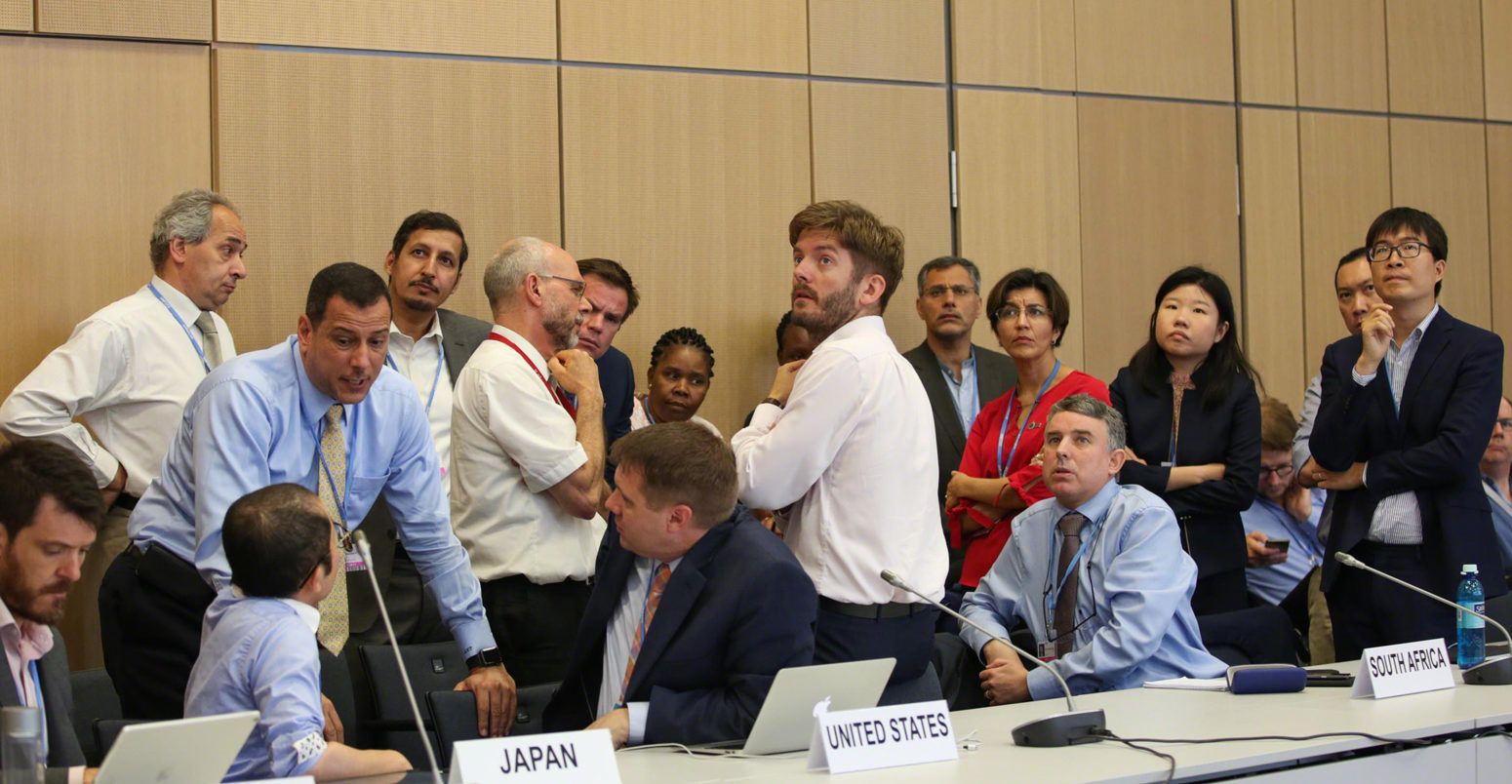
Bonn climate talks: Key outcomes from the June 2019 UN climate conference
Josh Gabbatiss
07.01.19Josh Gabbatiss
01.07.2019 | 4:57pmA record-breaking European heatwave provided a fitting backdrop to the latest round of UN climate change talks, in which delegates from around the world descended on Bonn for a two-week diplomatic effort.
The “intersessional” meeting takes place every year in the German city, midway between the annual conferences of the parties (COPs) which fall towards the end of the year.
This year, with a “rulebook” for the Paris Agreement largely settled at the December COP24 meeting in Katowice, Poland, the focus was primarily on hammering out a handful of contentious issues and laying the groundwork for the upcoming COP25 in the Chilean capital of Santiago.
In her opening speech, UN climate change executive secretary Patricia Espinosa sent a clear message about the “climate emergency” the world faces, and emphasised the importance of nations dramatically increasing their efforts to cut emissions.
But as temperatures soared to 37C outside the conference centre, the atmosphere inside also became heated as a group of nations sought to discredit a major report undertaken by the world’s leading climate scientists.
Meanwhile, over the course of the meeting, progress was slow in devising a system for trading carbon credits internationally, and many observers expressed concerns that the wealthiest nations were not taking their responsibilities to set more ambitious targets and provide climate finance seriously.
Carbon markets
Going into the conference, the most high-profile issue up for discussion was Article 6, the only aspect of the Paris “rulebook” that remained incomplete at the end of COP24. This focuses on rules for voluntary international trading of “mitigation outcomes” such as emissions reductions.
This section is seen as a critical part of the agreement as if it is handled badly, experts are concerned poor accounting could result in large amounts of extra emissions being produced, with ambition weakened as a result.
The goal at Bonn was to prepare a text for ministers to sign off at COP25, on a new trading system that would kick in beyond 2020 when the current one comes to an end, and as the Paris Agreement comes into force.
This means replacing the Clean Development Mechanism (CDM), which was established by the Kyoto Protocol in 1997. Under the CDM, richer nations could meet some of their climate targets by paying for emissions-cutting projects in developing nations, but there have been suggestions that many of the carbon credits generated by this scheme are effectively worthless. One EU report concluded that most clean energy projects paid for by the scheme would likely have happened anyway. It estimated that only 2% of CDM projects had a high likelihood of ensuring emissions reductions were “additional” to other measures.
There are three key sections of Article 6 that formed the basis of discussions at Bonn, the first being Article 6.2, which covers country-to-country trading of overachievements on national climate pledges. In contrast to this direct bilateral trading, Article 6.4 – which is intended to replace the CDM – involves a mechanism which will be governed by a new, separate body. Finally there is Article 6.8, which covers non-market mechanisms that must be determined in the coming few years.
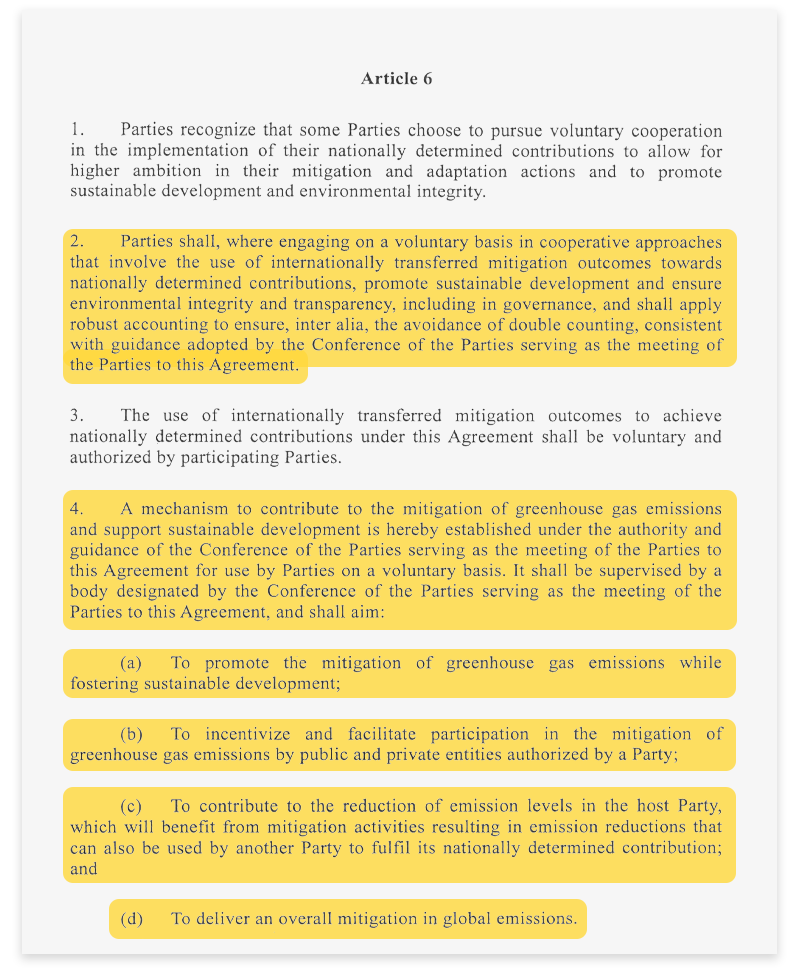
Article 6 of the Paris Agreement, with the sections relating to bilateral trading between countries and a new sustainable development mechanism. Source: UN
Speaking at a side event, Costa Rica negotiator Felipe de León summarised the importance of getting this process right:
“Article 6 is one of those rare birds that within our system could actually do proactive harm – if those rules are not good enough they are basically giving us licence to print fake money, and if you allow people to print fake money they start paying their bills with fake money. And in this case, because geophysics doesn’t care about how clever our accounting mechanisms are, it will come back to haunt us.”
A negotiator for the African Group, El Hadji Mbaye Diagne, agreed that while a functional market would be capable of raising climate ambitions, it had to be done right.
However, the technical and political complexity of the topic, and the breadth of opinion among different nations, mean progress has been slow in agreeing the Article 6 rules.
An important sticking point is the issue of avoiding “double counting”, wherein a nation that has successfully sold credits off the back of emissions cutting projects must not be allowed to also count those emissions cuts towards its own nationally determined contribution (NDC). Since the last COP, Brazil has resisted attempts to curtail double counting, a position it maintained in Bonn.
Together with the Arab Group and India, Brazil has also called for all existing credits from the CDM to be carried forward beyond 2020. As it stands, Brazil, India, China and South Korea hold virtually all of these credits, and the UN Framework Convention on Climate Change (UNFCCC) estimates there will be between 2.3-5.4 billion of them up to 2020. At the top end, this is equivalent to the EU’s entire annual emissions.
Members of the AOSIS group of small island states and the African Group want to avoid this transition, which they say would bring a huge surplus of weak credits into the market, reducing the need to actually cut emissions.
Another concern relates to Kyoto emissions reduction “units” created when countries beat the targets they had been given under the protocol – for example after the fall of the Soviet Union precipitated economic collapse and rapid, unplanned emissions cuts.
Gilles Dufrasne, a carbon pricing specialist at Carbon Market Watch, tells Carbon Brief that along with CDM credits, this Kyoto-era “hot air” amounts to up to around 15 billion tonnes of emissions, which could weaken Paris ambition.
Article 6 could create another source of potential hot air, Dufrasne says, if countries’ unambitious existing NDCs are easily overachieved and they are allowed to sell or carry forward credit for having beaten their weak targets. He points to research suggesting these additional carry-over units could amount to between 18 and 28 billion tonnes of CO2 equivalent. In combination, Dufrasne says this hot air could compromise the entire Paris Agreement system.
#SB50Bonn decided to further discuss Art 6.2, trading amongst Paris Parties @COP25CL. Nations managed to bundle all options in 1 doc https://t.co/Jy1KzPyWR7 There is more clarity but no consensus. It is said that Brazil wanted overrule @COP24 decision on avoiding double counting! pic.twitter.com/pmxBujUt5j
— Jos Cozijnsen (@timbales) June 27, 2019
Ahead of the meeting, it was generally agreed that by the end of the session in Bonn, parties needed to leave with a clear draft text concerning the future of carbon markets. This would have been put in front of ministers to consider ahead of the next COP so that the summit in Chile could sign off the final Article 6 rules. Instead, delegates in Bonn were only able to agree that were still littered with square-bracketed – in other words unresolved – sections.
Dufrasne tells Carbon Brief that while he saw greater understanding emerge of some of the technical challenges from delegates, progress was slow beyond combining two texts that had emerged from COP24 into one:
“It’s good that we now have one text – it’s much clearer, it’s easier to follow. On the other hand it feels a bit like we are back where we were a year ago when we ended the Bonn session and went back to COP with text that included all the options….I didn’t see a sign of any convergence.”
Essentially, Dufrasne says, on key topics such as double counting, Brazil and other strong-minded delegations were still in a similar position to the one they had entered the talks in. Ideally, nations want to have this set of rules finalised by the end of the next COP, but Jennifer Tollmann from green thinktank E3G tells Carbon Brief that ultimately a delayed trading system is preferable to an ineffective one. She says:
“If you can’t count carbon credits against your NDC that just means you have to do your NDC. Obviously that makes it a lot harder for some countries, but surely it’s better that some countries do their NDCs and actually do their mitigation instead of doing it through loopholes that essentially put a 1.5C pathway out of reach. This idea of wanting to get rules by the end of COP works if they are good rules [but] if done incorrectly this has the risk of fundamentally undermining the credibility of the Paris regime.”
IPCC 1.5C report
Discussions around how to respond to an Intergovernmental Panel on Climate Change (IPCC) special report on 1.5C were perhaps the most controversial to emerge in Bonn. Additional meetings had to be scheduled as proceedings drew to a close, amid concerns that no satisfactory conclusion would be reached before the closing plenary.
The issues arose after a handful of nations led by Saudi Arabia raised concerns about the fundamental science underlying the report, which was commissioned by the UN to explore the differences between 1.5C and 2C of warming. Other countries, particularly developing nations and small island states who say 1.5C threatens their very existence, refused to accept these apparent attempts to undermine the IPCC’s conclusions.
The furore was a continuation of a story that began in Katowice, when a coalition of fossil fuel-producing nations consisting of Saudi Arabia, Kuwait, Russia and the US refused to “welcome” the report, which had been released mere weeks earlier.
Closing plenary of #SB50Bonn and despite protestations from the chair, nations are falling over themselves to take the floor and emphasise the value of science/the IPCC – after opposition from Saudis and others to the 1.5 report. Apparently a “compromise” has been reached.
— Josh Gabbatiss (@Josh_Gabbatiss) June 27, 2019
Talks in Bonn aimed to reach an agreement on how to “consider” this report in future UN climate processes, set out in a text that would be concluded by the end of the meeting. As the days progressed the Saudis, with notable support from regional rivals Iran, and input from Russia and the US, tried to add in sections of text highlighting uncertainties within the report and questioning its usefulness. Specifically, paragraphs were added to the text that emphasised “scientific knowledge gaps”.
This was viewed as unacceptable by many present, as Alden Meyer, policy director at the Union of Concerned Scientists tells Carbon Brief:
“It’s just disrespectful to the IPCC and the world scientific community to play these kinds of games with this report. The report should be informing the negotiations on a number of tracks, as well as what actions countries are taking under the Paris Agreement to meet their nationally determined contributions (NDCs).”
This sentiment was echoed by Carlos Fuller, a Belizean who leads AOSIS. He praised the report, which was commissioned by the UN following the creation of the Paris Agreement and was the product of three years of work by scientists reviewing around 6,000 studies. “Who are we to tell the doctors that their conclusions are wrong? What we do need to resolve is how do we use that scientific information and act on it,” he tells Carbon Brief.
As for the motivation behind the opposition to the report, particularly by Saudi Arabia with its petrochemical-dominated economy, Meyer says this is clear:
“They are desperately trying to block the report’s findings from influencing both the negotiations and national level action…because it obviously has implications for future demand for oil.”
While the IPCC’s report itself did not suggest policy changes, it made clear that to keep global warming below 1.5C – a target necessary to avoid many of its worst impacts – emissions would have to be cut by 45% by 2030. Such a global effort would require an unprecedented transition away from fossil fuels.
As part of the discussions, the small island states, as well as Latin American nations and the Least Developed Countries group proposed two workshops to guide nations’ responses to the 1.5C target, to be held in December and next summer in Bonn. According to Fuller, these sessions would have consisted of one to understand the mitigation and adaptation measures required by nations, and also the funding required to achieve them. Given its issues with the underlying science, Saudi Arabia also rejected this proposal.
An extra negotiating session on Wednesday failed to reach an agreement. As a result, the French chief negotiator Paul Watkinson, who chairs the Subsidiary Body for Scientific and Technological Advice (SBSTA) that oversees this area, took the text to a closed meeting that evening.
By the time of the closing plenary, an “agreement” had been finalised, although not a popular one. A “watered-down” five paragraph version of the document was produced that included a reference to the IPCC report being “the best available science”, and no longer emphasised “uncertainties”, but also removed any formal inclusion of its findings in future UN negotiations.
Many nations made their displeasure felt at the closing plenary. The Environmental Integrity Group of delegates arrived in T-shirts saying “science is not negotiable”, and Ian Fry, the lead negotiator from Tuvalu, took the floor to state the “existential threat” facing his country and say the report should be “welcomed, accepted and not negotiated”. Despite making protestations about the number of delegates taking the floor, Watkinson too emphasised the importance of science to the UN climate process after announcing the agreement.
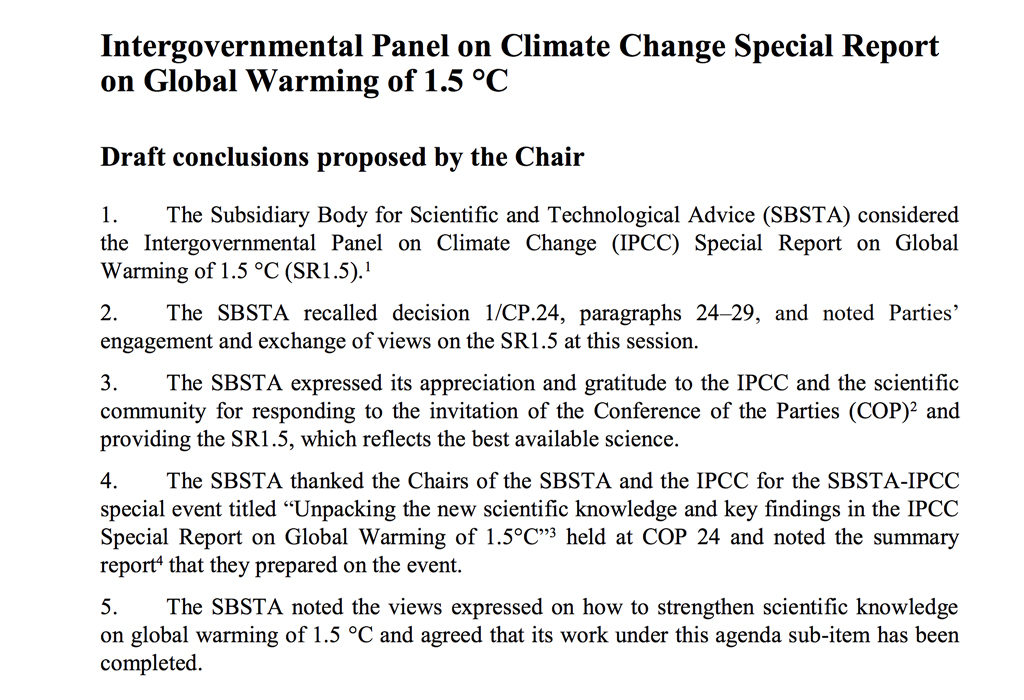
The final draft text regarding the IPCC report, agreed upon by delegates. Source: UNFCCC
Raising ambition
With the years of negotiations that have followed the 2015 Paris Agreement coming to a close, next year will be the start of the vital next stage: implementation. Countries are due to update their NDCs in 2020, and it is widely accepted they must significantly ramp up their ambition, particularly if there is any hope of hitting the 1.5C target discussed in the IPCC’s report.
The need for developed nations in particular to take this mission seriously was emphasised by Fuller, in his capacity as a representative of small island states. He tells Carbon Brief:
“Based on the IPCC report, we only have 11 years to cut emissions by 50% if we are going to achieve that 1.5C target. We only have that window of opportunity to revise the NDCs.”
In September, leaders have been told to bring plans for raising their NDC ambitions to the Climate Action Summit in New York that has been organised by UN secretary-general Antonio Guterres (following a “stock take” in Abu Dhabi the weekend immediately after Bonn).
The German conference was therefore seen as an opportunity to discuss these efforts, and issues relating to climate pledges and finance were a key topic of discussion in the corridors. The UN has already reported that it expects 80 countries, including big-hitters such as China, to signal an increase in ambition in New York. Such progress will be necessary because existing NDCs are insufficient to meet the Paris limit of “well below 2C”, and nations are not even on track to meet them.
Over the course of the conference, 28 countries including the UK, Nigeria and Brazil presented their current efforts to their peers, providing an arena for scrutiny. Meanwhile a booth run by the World Resources Institute (WRI) recorded pledges from nearly 30 developing nations to strengthen their NDCs next year. Notable by their absence from this booth were representatives from the industrialised nations who account for the vast majority of global emissions.
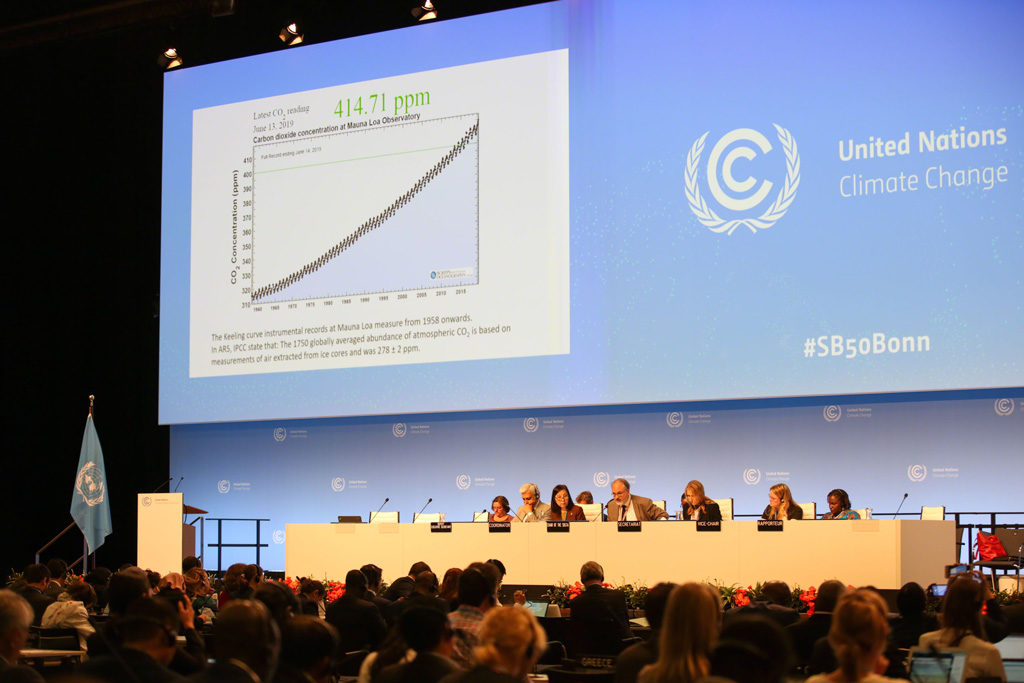
The Keeling curve showing the accumulation of CO2 in the Earth’s atmosphere was displayed behind the SBSTA chair during the closing session. Photo by IISD/ENB | Kiara Worth
While talks were underway in Bonn, hopes for renewed ambition suffered several blows from beyond the walls of the conference centre. After initial optimism that EU leaders would agree to target net-zero emissions by 2050, the Czech Republic, Estonia, Hungary and Poland blocked the deal – though the EU could still agree to raise its ambition later in the year. There were also concerns as G20 leaders gathered in the Japanese city of Osaka, with reports emerging of US efforts to weaken the group’s language around climate change.
However, there were positive words from some delegates for the UK’s recent commitment to a net-zero target for 2050. As the G20 summit came to an end, after US president Donald Trump refused to back a declaration supporting the Paris Agreement, France and China united to reiterate their commitment to updating their NDC pledges.
Overall, the hoped-for choreography towards a successful round of ambition-raising next year has only partially fallen into place. Yamide Dagnet, project director on international climate action at the World Resources Institute (WRI), explains her concerns to Carbon Brief:
“It’s all about ambition, ambition. There’s going to be the UNSG [New York] summit, the replenishment of the Green Climate Fund (GCF), so people here had all those big moments in their minds…there have been concerns about the signals coming from the G20, from the EU, which lack the ambition we were expecting to see at this moment.”
Climate finance – a topic that tends to receive a lot of attention in UN negotiations – was not a key part of the formal discussions at Bonn. However, it featured prominently in informal discussions in the corridors, particularly with a GCF board meeting in South Korea, and the subsequent replenishment of the fund, looming.
This fund is the world’s primary mechanism for richer nations to help the developing world to meet its climate goals, and Dagnet emphasises the need for nations’ ambition and finance commitments to “work in tandem” to achieve the Paris Agreement targets. While the US has withdrawn its support from the fund, Norway and Germany have doubled their initial pledges.
Loss and damage
Another key focus at the event was “loss and damage” – how to deal with the impacts of climate change that can neither be avoided by cutting emissions, nor defended against by investing in adaptation measures. This is a sensitive topic, particularly for developing nations that stand to lose the most as a result of sea level rise, desertification and other threats.
In Bonn, parties were expected to reach agreement on the “terms of reference”, including scope and expected outputs, for a review of the Warsaw International Mechanism (WIM). This was first established six years ago at COP19 in Poland as a means of dealing with the impact of climate change in vulnerable developing countries, including both extreme and slow-onset events.
Loss and damage is a highly politicised issue that has hampered UN negotiations in the past. Though the formal review of the WIM is set to take place at COP25, a major division has emerged between developed and developing nations over what it will cover. Developed nations only want to consider past events, while developing nations want it to also look forward and identify ways to mobilise more support for loss and damage in the future.
Parties came to an agreement on how they planned to undertake the review, but Meyer says this will still be “a big issue in Santiago”, given the significant differences of opinion that remain.
Adao Soares Barbosa, a negotiator from Timor-Leste and loss and damage lead coordinator for the Least Developed Countries group tells Carbon Brief it is “vitally important” for developed countries to cooperate on this issue “as many lives depend upon it”. He says:
“COP25 in Santiago will be the real test. Developed countries have indicated they want to limit the scope and functions of the WIM, which was set up to address loss and damage in vulnerable countries. We need all countries to come together to understand not just what has been done in the past, but how to make sure current frameworks can be improved to meet the needs of vulnerable developing countries in the future.”
Meyer says the US and other industrialised nations are unwilling to create a whole new stream of climate finance, in addition to mitigation and adaptation – preferring instead that loss and damage is lumped in with adaptation. Developing nations, on the other hand, note that many of the phenomena being considered – including more frequent natural disasters and the loss of land – go beyond mere adaptation. “If you met their legitimate needs, it has a big price tag,” says Meyer.
On the fringes of the event in Bonn, representatives from NGOs expressed frustration that developed nations were not taking their funding responsibilities seriously, drawing particular attention to the loss and damage mechanism.
At a press conference on the final day, Harjeet Singh from ActionAid said nations were “passing the buck” when conversation turned to finance to deal with the aftermath of “climate emergencies”. He pointed to Cyclone Idai and the damage it has caused in south eastern Africa as an example of an event that required such funding:
“If we miss the opportunity this year when it is clearly on the agenda…rebooting this institution to speak out and respond to the reality on the ground, we will be failing as this international community, our leaders will be failing us.”
Separately, campaigners raised concerns about what they called the “corporate capture” of the event. They accused negotiators of “scrubbing” hours of discussions around the fossil fuel industry’s influence on UN proceedings from the final conclusions.
Groups representing the industry are permitted to attend the event as observers, and during sessions discussing transparency, delegates from developing nations in particular repeatedly raised the issue of conflicts of interest. However, the text that emerged from these meetings did not mention the topic. Responding to this, Sriram Madhusoodanan, deputy campaigns director at the group Corporate Accountability said the US, Australia, the EU and Norway had used “bullying and intimidation” to defend fossil fuel interests at the talks.
Looking ahead
Several technical issues remain unresolved following the conference in Bonn, which will have to be picked up at the COP in Santiago. Besides aiming for agreement around challenges such as Article 6 market mechanisms and loss and damage, these will include devising common timeframes so that nations’ climate pledges cover the same lengths of time from 2031 onwards.
Parties also decided to postpone discussions about the second periodic review of the long-term goal of the UNFCCC, amid reports of divisions between developed and developing parties on the topic.
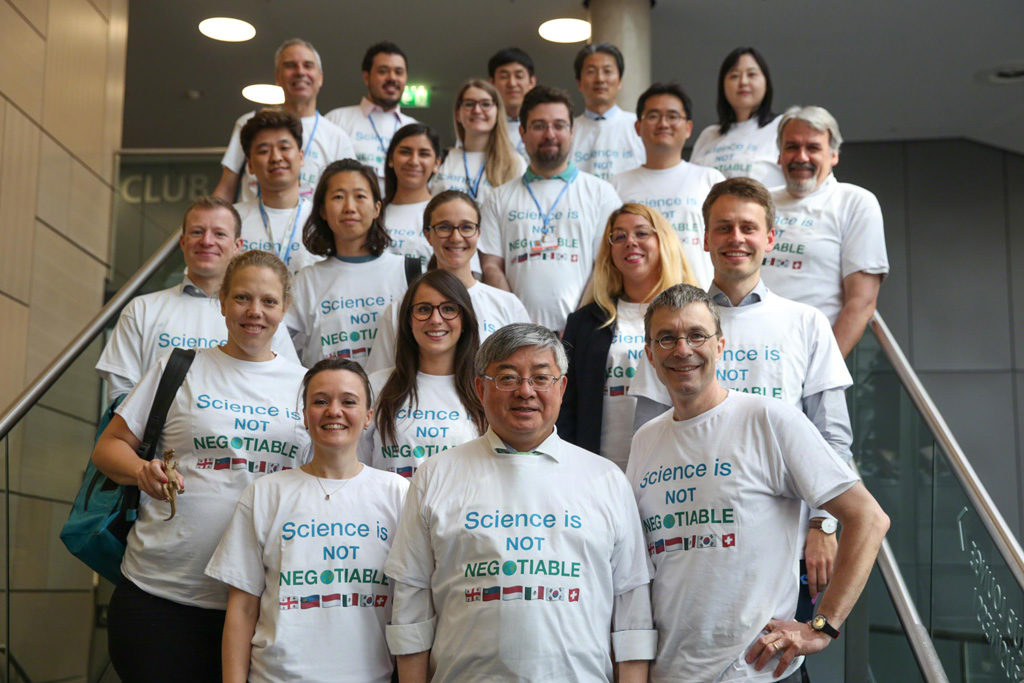 IISD/ENB | Kiara Worth</a>" width="1024" height="683" srcset="https://www.carbonbrief.org/wp-content/uploads/2019/07/ENB_SB50_27June19_KiaraWorth.jpg 1024w, https://www.carbonbrief.org/wp-content/uploads/2019/07/ENB_SB50_27June19_KiaraWorth-270x180.jpg 270w, https://www.carbonbrief.org/wp-content/uploads/2019/07/ENB_SB50_27June19_KiaraWorth-300x200.jpg 300w, https://www.carbonbrief.org/wp-content/uploads/2019/07/ENB_SB50_27June19_KiaraWorth-768x512.jpg 768w, https://www.carbonbrief.org/wp-content/uploads/2019/07/ENB_SB50_27June19_KiaraWorth-107x71.jpg 107w, https://www.carbonbrief.org/wp-content/uploads/2019/07/ENB_SB50_27June19_KiaraWorth-200x133.jpg 200w, https://www.carbonbrief.org/wp-content/uploads/2019/07/ENB_SB50_27June19_KiaraWorth-420x280.jpg 420w" sizes="(max-width: 1024px) 100vw, 1024px" />
IISD/ENB | Kiara Worth</a>" width="1024" height="683" srcset="https://www.carbonbrief.org/wp-content/uploads/2019/07/ENB_SB50_27June19_KiaraWorth.jpg 1024w, https://www.carbonbrief.org/wp-content/uploads/2019/07/ENB_SB50_27June19_KiaraWorth-270x180.jpg 270w, https://www.carbonbrief.org/wp-content/uploads/2019/07/ENB_SB50_27June19_KiaraWorth-300x200.jpg 300w, https://www.carbonbrief.org/wp-content/uploads/2019/07/ENB_SB50_27June19_KiaraWorth-768x512.jpg 768w, https://www.carbonbrief.org/wp-content/uploads/2019/07/ENB_SB50_27June19_KiaraWorth-107x71.jpg 107w, https://www.carbonbrief.org/wp-content/uploads/2019/07/ENB_SB50_27June19_KiaraWorth-200x133.jpg 200w, https://www.carbonbrief.org/wp-content/uploads/2019/07/ENB_SB50_27June19_KiaraWorth-420x280.jpg 420w" sizes="(max-width: 1024px) 100vw, 1024px" />Members of the Environmental Integrity Group arrived at the closing plenary in T-shirts saying “science is not negotiable”. Photo by IISD/ENB | Kiara Worth
This goal, which sits above the Paris Agreement, focuses on reducing greenhouse gas emissions to safe levels so as to avoid “dangerous anthropogenic interference with the climate system”. The review is set to take place between 2020 and 2022, with the first round – published in the months ahead of COP21 – seen as having been a key stepping stone towards the Paris Agreement’s adoption of a 1.5C aspiration.
Observers said developed nations were concerned developing nations were going to use the situation as an opportunity to “point fingers” over their emissions and contribution to climate change over the years.
Discussions also continued around the Koronivia Joint Work on Agriculture, with similar divisions emerging. The African Group and other developing nations have called for more money to support adaptation measures for their farmers, something developing nations have opposed.
However, after hearing from various funding bodies in Katowice, ActionAid climate policy coordinator Teresa Anderson tells Carbon Brief it became clear they “don’t really understand agriculture and how to fund it”. She explains that existing finance is not sufficiently benefiting farmers on the ground, and this realisation led to an agreement in Bonn to create guidance that ensures money for agriculture is well spent. Parties also agreed on an additional workshop on sustainable land and water management to take place in New Zealand next year.
Success in these complex areas at the upcoming COP will partly be dependent on the ability of the Chilean presidency to set out a clear vision for COP25. With two more IPCC reports – on land use and the cryosphere – expected in the coming months, there will also be pressure on supportive nations and the presidency to give them a better welcome than the 1.5C report and provide space for their inclusion in formal UN climate processes.
While delegates in Bonn were positive about the signals emerging from Chile ahead of the COP, there was some criticism among NGOs over the nation’s lack of support for a new regional effort to protect people and groups involved in environmental protection. Enrique Maurtua Konsatanitinidis, senior adviser on climate change for the Fundación Ambiente y Recursos Naturales (FARN), says this was despite its role in assembling the landmark Escazú Agreement. He tells Carbon Brief the nation’s support for the initiative would help demonstrate Chile’s role as a regional environmental leader:
“Chile has been showing a lot of progress and leadership in this process for years…The one things Chile needs to do now is complete the cycle, sign the document, ratify it and be part of those countries that are in line with building a strong environmental democracy in the region.”
Another issue that emerged in Bonn was a dispute over the future funding of the budget for running the UNFCCC itself. Given the increase in workload expected following the adoption of the Paris rulebook last year, the secretariat requested a 26% funding boost for the 2020-2021 period. This proved unpopular among developed nations in particular – which have to finance its work – and the final figure ended up as a 5% increase.
One key announcement that never materialised at Bonn was the location of next year’s COP26. The event will be a critical moment in the climate calendar, coming as the Paris Agreement finally takes hold and nations must confirm their strengthened NDCs.
The UK, in partnership with Italy, is thought to be the favourite to host the event, with confirmation initially expected towards the end of the Bonn summit. However, with Turkey still in the running, the decision was delayed and is now expected to be resolved around the time of the New York event.
| Date | Event |
|---|---|
| 6-8 July 2019 | 23rd meeting of the Board of the Green Climate Fund (GCF) |
| 16 August 2019 | IPCC special report on climate change and land |
| 24-26 August 2019 | G7 summit in Biarritz, France |
| 20 September 2019 | IPCC special report on ocean and cryosphere in a changing climate |
| 20-21 September 2019 | 56th Meeting of the European Council |
| 23 September 2019 | UN 2019 climate summit in New York, US |
| 24-25 September 2019 | UN high-level political forum on sustainable development in New York, US |
| 26 September 2019 | UN high-level dialogue on financing for development in New York, US |
| 23-26 October 2019 | International Renewable Energy Conference in Seoul, Korea |
| 4-8 November 2019 | 31st meeting of parties to Montreal Protocol |
| 8-10 October 2019 | Pre-COP in Costa Rica |
| 2-13 December 2019 | COP25 in Chile |
| March 2020 (tbc) | Intersessional workshop on sustainable land and water management in New Zealand |
-
Bonn climate talks: key outcomes from the June 2019 UN climate conference

